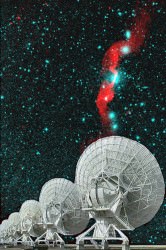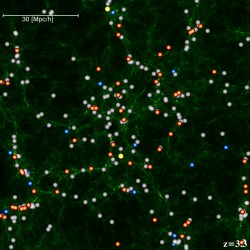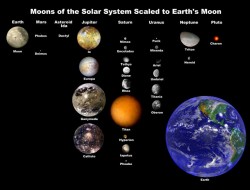There’s a lot you can learn by just staring at an object, watching how it changes in brightness. This is the technique of photometry, and it has helped astronomers discover variable stars, extrasolar planets, minor planets, supernovae, and much more.
Continue reading “Astronomy Cast Ep. 337: Photometry”
How Will Aliens Find Us?
Trying to keep a low profile, to prevent the aliens from invading? Bad news. Life has actually been broadcasting our existence to the Universe for hundreds of millions of years.
Have you heard these crazy plans to send signals out into deep space? What if evil aliens receive them, come steal our water, enslave, eat, and use us as guinea pigs for their exotic probulators. How we could stop these madmen from announcing our presence to the galaxy? A petition on whitehouse.gov? An all caps Facebook group? An all pusheen protest? Somebody call Reddit, they’ll know what to do.
If this is a worry for you and your friends, I’ve got bad news, or possibly good news depending on which side you come down on. We’ve already been broadcasting our existence for hundreds of millions of years. If aliens wanted to know we were here, all they needed to do was look through their telescopes.
We’re in a golden age of extrasolar planet discovery, recently crossing the thousand-planets-mark thanks to Kepler and other space telescopes. With all these amazing planetary candidates, our next challenge will be to study the atmospheres of these planets, searching for evidence of life. There are chemicals which are naturally occurring, like water and carbon dioxide, and there are substances that can only be present if some source is replenishing them. Methane, for example, would only last only few hundred years in the atmosphere if it wasn’t for farting cows and colonies of bacteria eating dead things.
If we see methane or oxygen in the atmosphere of an extrasolar planet, we’ll have a good idea there’s life there. And if we see the byproducts of an industrial civilization, like air pollution, we can pinpoint exactly where they are in their technical development. It will work for us, and that means it would work for aliens.
For the first few billion years, oxygen was toxic. But then cyanobacteria evolved photosynthesis and figured out how to work with oxygen more than 2.4 billion years ago. This is known as the Great Oxidation Event.
For the first billion years, all this biologically generated oxygen was absorbed by the oceans and the rocks. Once those oxygen sinks filled up, oxygen began accumulating in the atmosphere. By 500 million years ago, there was enough oxygen in the atmosphere to support the kind of breathing we do today. And this much oxygen would have been obvious to the aliens. They would have known that life had evolved here on Earth, and they could have sent out their berserker spaceships to steal our water and made us watch while they ate all our small rodents.
If the aliens waited, we would have given them more signs. The Industrial Revolution began in the mid 1700’s. And this time, it was humans that filled the atmosphere with the pollution of our industrial processes. Again, aliens watching the planet with their space telescopes would know the moment we became a technological civilization.

In the 20th century, we harnessed the power of radio transmissions, and began sending our messages out into space. For about a hundred years now, our transmissions have been expanding into a bubble of space. And so, any aliens listening within this expanding sphere of space might have a chance of hearing us. They know we’re here, and they know some of us really like Ke$ha.
And finally, for the last few decades, a few groups have tried broadcasting messages using our powerful radio telescopes directly at other stars. These messages haven’t gotten very far, but I honestly wouldn’t worry. Life itself gave away our position hundreds of millions of years ago. And life will help us find other civilizations, if they’re out there.
What do you think? Should we turn out the lights and pretend like we’re not home or keep on actively broadcasting our presence to the Universe? Tell us what you think we should do in the comments below.
Virtual Star Party – March 9, 2014: James’ Intimate View of the Moon
Hosts: Fraser Cain & Scott Lewis
Astronomers: James McGee, Gary Gonella, Tom Nathe, Russell Bateman & Peter Lake
Continue reading “Virtual Star Party – March 9, 2014: James’ Intimate View of the Moon”
Weekly Space Hangout – March 7, 2014: Cosmos Premiere & NASA Budget
Host: Fraser Cain
Astrojournalists: David Dickinson, Matthew Francis, Casey Dreier, Jason Major, Brian Koberlein, Alan Boyle
This week’s stories:
Alan Boyle (@b0yle, cosmiclog.com ):
Cosmos premiere!
David Andrew Dickinson (@astroguyz):
Watch the Close Pass of NEO 2014 DX110
Daylight Saving time: A Spring Forward or a Step Back?
A Natural Planetary Defense Against Solar Storms
Matthew Francis (@DrMRFrancis, BowlerHatScience.org):
Using gravitational lensing to measure a spinning quasar
CosmoAcademy classes
Casey Dreier (Planetary.org):
The 2015 NASA Budget Request
NASA Kinda Embraces Exploring Europa
Jason Major (@JPMajor, LightsInTheDark.com):
That’s the way the asteroid crumbles
Brian Koberlein (@briankoberlein, briankoberlein.com):
*Possible* evidence for dark matter WIMPs
Black Holes exceed Eddington limit
Using quasars in a quantum experiment
We record the Weekly Space Hangout every Friday at 12:00 pm Pacific / 3:00 pm Eastern. You can watch us live on Google+, Universe Today, or the Universe Today YouTube page.
Why Is This A Special Time For The Universe?
You might be surprised to know that you’re living in a very special time in the Universe. And in the far future, our descendant astronomers will wish they could live in such an exciting time Let’s find out why.
You might be interested to know that you are living in a unique important and special time in the age of the Universe. Our view of the night sky won’t be around forever, in fact, as we think about the vast time that lies ahead, our time in the Universe will sound very special.
Astronomers figure the Universe has been around for 13.8 billion years. Everything in the entire Universe was once collected together into a singularity of space and time. And then, in a flash, Big Bang. Within a fraction of a second, the fundamental forces of the Universe came into existence, followed by the earliest types of matter and energy. For a few minutes, the entire Universe was like a core of a star, fusing hydrogen into helium. Approximately 377,000 years after the Big Bang, the entire Universe had cooled to the point that it became transparent. We see this flash of released light as the Cosmic Microwave Background Radiation.
Over the next few billion years, the first stars and galaxies formed, leading to the large scale structures of the Universe. These new galaxies with their furious star formation would have been an amazing sight. It would have been a very special time in the Universe, but it’s not our time.
Over the next few billion years, the Universe continued to expand. And it was during this time that the mysterious force called dark energy crept in, further driving the expansion of the Universe. We don’t know what dark energy is, but we know it’s a constant pressure that’s accelerating the expansion of the Universe.
As the volume of the Universe increases, the rate of its expansion increases. And over vast periods of time, it’ll make the Universe unrecognizable from what we see today. The further we look out into space, the faster galaxies are moving away from us. There are galaxies moving away from us faster than the speed of light. In other words, the light from those galaxies will never reach us.

As dark energy increases, more and more galaxies will cross this cosmic horizon, invisible to us forever. And so, we can imagine a time in the far future, where the Cosmic Microwave Background Radiation has been stretched away until it’s undetectable. And eventually there will be a time when there will be no other galaxies visible in the night sky. Future astronomers will see a Universe without a cosmological history. There will be no way to know that there was ever a Big Bang, that there was ever a large scale structure to the Universe.
So how long will this be? According to Dr. Lawrence Krauss and Robert J. Scherrer, in as soon as 100 billion years, there will be no way to see other galaxies and calculate their velocity away from us. That sounds like a long time, but there are red dwarf stars that could live for more than a trillion years. We will have lost our history forever.
Cherish and make the most of these next hundred billion years. Keep our history alive and remember to tell our great great grandchildren and their robotic companions the tales of a time when we knew about the Big Bang.
What about you? What would you go see if you could witness any astronomical event in the history of the universe?
How Do You Kill a Black Hole?
Black holes want to absorb all matter and energy in the Universe. It’s just a matter of time. So what can we do to fight back? What superweapons have been devised to destroy black holes?
Black holes are the natural enemies of all spacefaring races. With their bottomless capacity to consume all light and matter, it’s just a few septillion years before all things in the Universe have found their way into the cavernous maw of a black hole, crushed into the infinitely dense singularity. If Star Trek has taught us anything, it’s that it’s mankind’s imperative to survive against all odds.
So will we take this lying down?
Heck no!
Will we strike first and destroy the black holes before they destroy us?
Heck yes!
But how? How could you kill a black hole?
This… gets a little tricky.
Continue reading “How Do You Kill a Black Hole?”
Astronomy Cast Ep. 336: Units of Measure
How heavy is a kilogram, how long is a second? How warm is a degree? We measure our Universe is so many different ways, using different units of measurement. But how do scientists come up with measurement tools which are purely objective?
Continue reading “Astronomy Cast Ep. 336: Units of Measure”
Weekly Space Hangout – February 28, 2014: Good NASA News and 715 Confirmed Planets!
Host: Fraser Cain
Astrojournalists: Morgan Rehnberg, David Dickinson, Elizabeth Howell, Jason Major, Casey Dreier, Mike Simmons
Continue reading “Weekly Space Hangout – February 28, 2014: Good NASA News and 715 Confirmed Planets!”
Can Moons Have Moons?
The Earth has a single moon, while Saturn has more than 60, with new moons being discovered all the time. But here’s a question, can a moon have a moon? Can that moon’s moon have its own moon? Can it be moons all the way down?
First, consider that we have a completely subjective idea of what a moon is. The Moon orbits the Earth, and the Earth orbits the Sun, and the Sun orbits the center of the Milky Way, which orbits within the Local Group, which is a part of the Virgo Supercluster. The motions of objects in the cosmos act like a set of Russian nesting dolls, with things orbiting things, which orbit other things. So maybe a better question is: could any of the moons in the Solar System have moons of their own? Well actually, one does.
Right now, NASA’s Lunar Reconnaissance Orbiter is happily orbiting around the Moon, photographing the place in high resolution. But humans sent it to the Moon, and just like all the artificial satellites sent there in the past, it’s doomed. No satellite we’ve sent to the Moon has ever orbited for longer than a few years before crashing down into the lunar surface. In theory, you could probably get a satellite to last a few hundred years around the Moon.
But why? How come we can’t make moons for our moon to have a moon of it’s own for all time? It all comes down to gravity and tidal forces. Every object in the Universe is surrounded by an invisible sphere of gravity. Anything within this volume, which astronomers call the “Hill Sphere”, will tend to orbit the object.
So, if you had the Moon out in the middle of space, without any interactions, it could easily have multiple moons orbiting around it. But you get problems when you have these overlapping spheres of influence. The strength of gravity from the Earth tangles with the force of gravity from the Moon.

Although a spacecraft can orbit the Moon for a while, it’s just not stable. The tidal forces will cause the spacecraft’s orbit to decay until it crashes. But further out in the Solar System, there are tiny asteroids with even tinier moons. This is possible because they’re so far away from the Sun. Bring these asteroids closer to the Sun, and someone’s losing a moon.
The object with the largest Hill Sphere in the Solar System is Neptune. Because it’s so far away from the Sun, and it’s so massive, it can truly influence its environment. You could imagine a massive moon distantly orbiting Neptune, and around that moon, there could be a moon of its own. But this doesn’t appear to be the case.
NASA is considering a mission to capture an asteroid and put it into orbit around the Moon. This would be safer than having it orbit the Earth, but still keep it close enough to extract resources. But without any kind of orbital boost, those tidal forces will eventually crash it onto the Moon. So no, in our Solar System, we don’t know of any moons with moons of their own. In fact, we don’t even have a name for them. What would you suggest?
Virtual Star Party – February 23, 2014 – Nebulae, Sunspots, and Planet “X”?!?
Hosts: Fraser Cain & Scott Lewis
Astronomers: David Dickinson, Gary Gonella, James McGee, Mike Simmons, Roy Salisbury, Shahrin Ahmad, Tom Nathe
Tonight’s views:
Jupiter with a nice view of the red spot, Venus approaching zenith, Bubble Nebula, the Pleiades, Orion Nebula, Horsehead Nebula, Flame Nebula, Running Man Nebula, the Moon, the Sun, the ISS (photo), the Rosette Nebula, Orion again, M33, Sunspots, Rosette again, California Nebula (multiple views), M81 & M82, Planet “X” (?!?), Andromeda, Flame Nebula again
We hold the Virtual Star Party every Sunday night as a live Google+ Hangout on Air. We begin the show when it gets dark on the West Coast. If you want to get a notification, make sure you circle the Virtual Star Party on Google+. You can watch on our YouTube channel or here on Universe Today.




